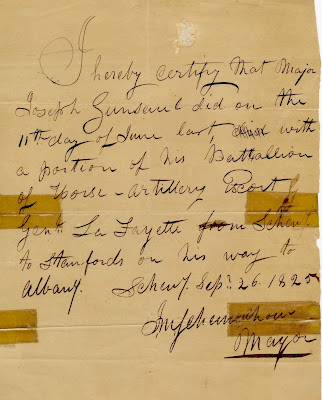Thanks to library volunteer Diane Leone who helped research this post.
 |
| Portrait of the Marquis de Lafayette by Charles Willson Peale in 1779-1780. Courtesy of Washington and Lee University |
 |
| Silk Ribbon with an engraving of Lafayette by Myron King of Troy, NY. Courtesy of the Grems-Doolittle Library Collections |
Lafayette first visited Schenectady in 1778 during the American Revolution to investigate a conspiracy that supposedly involved some residents of Schenectady. He concluded that the suspicions of a conspiracy were “very far from groundless” in a March 3rd report to the Albany Committee of Safety. He personally questioned a suspected soldier about the conspiracy and while he could not retrieve a confession, Lafayette was sure that there was a treasonous plot forming in Schenectady. The suspicion was based on a report that British Major Christopher Carleton, nephew of Canada’s Governor Guy Carleton, was seen in Schenectady making preparations and gathering information. An attempt was made to capture Major Carleton and Lafayette even offered a reward of fifty guineas for his arrest. Lafayette’s suspicion was correct and Major Carleton went on to run a very successful raid along the shores of Lake Champlain in the fall of 1778.
Lafayette’s second visit to Schenectady occurred on his momentous tour of the United States which began on August 15, 1824. According to Larry Hart, Schenectady’s Common Council created a committee in 1824 to convince Lafayette to visit Schenectady. The committee was made up of some of Schenectady’s most prominent citizens including Union College President Eliphalet Nott, James Duane and John Vrooman among others. This committee met Lafayette on his way from New York City to Albany and while Lafayette couldn’t make the visit right away, he promised to visit the next year. The newspaper, The Schenectady Cabinet had been dedicating a page per issue to Lafayette’s visit to America. The Cabinet was so sure that Lafayette would visit Schenectady after his trip to Albany that in their September 7th, 1824 issue they stated that “La Fayette, it is understood, may be expected in this city within a few days.” The proclamation was a bit premature, as Lafayette was not able to make his visit until June 11, 1825 on his way back from Little Falls.
Schenectady was more than ready for his scheduled arrival. As Lafayette was traveling down the partially constructed Erie Canal from Little Falls on the day before his Schenectady arrival, members from an arrangements committee traveled up the canal to meet the esteemed general and his party. When the committee reached Lafayette, a messenger was sent back to Schenectady to tell everyone what time he would be arriving. At 7 p.m. on Saturday, June 11, cannons and heavy artillery that were set up on the canal bridge near Water Street shook Schenectady, notifying its inhabitants of Lafayette’s arrival. According to a September 26, 1933 recollection of the visit from the Schenectady Union-Star, “All was bustle and suppressed excitement. The people crowded the canal bridges and assembled on both banks of the canal all the way from the flats to the City Hall.” The continuous shout of “Welcome Lafayette” rang along the streets. The packet boat that carried Lafayette and his party eventually reached City Hall where they were greeted by Mayor Isaac Schermerhorn. He was then introduced to the Common Council and surviving Revolutionary War heroes. Over forty years after the end of the American Revolutionary War, General Lafayette still recognized James Lighthall, one of the veterans who served with Lafayette during the war. Lafayette went on to express his appreciation to Schenectady at a dinner in the Givens Hotel by saying that “Schenectady had been most kind in times of danger to a young commander who now comes here after a lapse of 47 years, to offer his affectionate devotion, good wishes and the tribute of his old and new feelings of respect and gratitude.” Lafayette's visit to Schenectady only lasted three hours, but his legacy resonated with its residents.
 |
| Copy of Lafayette's response to Governor Yates' farewell address, written by Lafayette's secretary Auguste Levasseur. Courtesy of the Grems-Doolittle Library Collection. |
Lafayette Street is one of the most prominent examples of the Marquis' influence here. When a new street was to be opened in the early-1800s citizens of Schenectady suggested naming it Lafayette Street instead of Division Street. The Common Council agreed and unanimously voted to name it
Lafayette Street. Lafayette’s visit influenced the arts in Schenectady as was witnessed
in a play called The Pageant of
Schenectady by Constance D’Arcy Mackay. The
Pageant of Schenectady was produced
in 1912 and featured Lafayette’s highly esteemed visit. It was a five-part play commemorating the 250th
anniversary of the founding of Schenectady. Performed on May 30th
through June 1st in 1912, it follows Schenectady’s history from the
early Native Americans to “The Intellectual and Industrial Forces of the City
of Today.” Lafayette’s visit to Schenectady apparently stuck out in the mind
of the playwright who dedicated an entire episode of the play to Lafayette’s
arrival. Titled “The Welcome to Lafayette”, this episode follows Mrs. Van Epps,
Elsbett Van Epps, Barent Sanders, and a group of children as they organize a
reception for Lafayette. Mrs. Van Epps remarks that “To think of him is to
remember the cause of American Liberty.”
 |
| Excerpt from Harold A. Larrabee's "Lafayette at Schenectady." Courtesy of the Grems-Doolittle Library Collection. |












